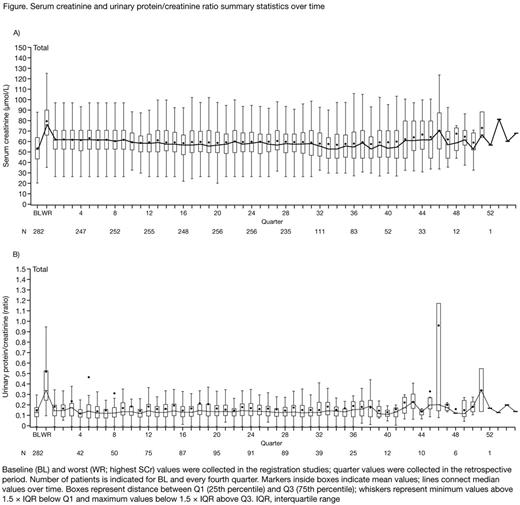Abstract
Background: Patients (pts) with transfusion-dependent anemias now have longer life expectancy due to improved quality of care, in particular iron chelation therapy (ICT). Longer life and drug exposure increase the chance of complications, such as changes in renal function, which may be age-, disease- or drug-related. In light of lifelong transfusions and dependence on ICT, it is relevant to understand the long-term ICT safety profile. Published data show some pts receiving ICT experience changes in markers of renal function, mostly within normal limits, non-progressive and reversible with dose reduction and/or interruption, although follow-up was limited to ≤5 years. This retrospective study assessed long-term renal safety of deferasirox in Italian pts with transfusional hemosiderosis who participated in the deferasirox registration studies and continued treatment for up to 10 or more yrs.
Methods: Italian pts with β thalassemia, sickle cell disease, MDS or other anemias who participated in deferasirox registration studies and extensions (studies 105, 106, 107, 108 or 109), received ≥1 dose of deferasirox, had ≥1 post-baseline (BL) serum creatinine (SCr) measurement, and had medical records available could be included. BL and worst values were recorded during the prospective studies; values were collected retrospectively in 3-month periods from registration trial end until the latest pt assessment for SCr, urinary protein/creatinine ratio (UPCR) and creatinine clearance (CrCl, if available). Primary endpoint was SCr trend over time. Secondary endpoints included notable renal function values (SCr >33% increase from BL and >ULN at two consecutive measurements ≥7 days apart; CrCl <60 mL/min; UPCR ≥1.0 mg/mg) and evaluation of renal AEs from registration study end to retrospective period end.
Results: Of the 366 Italian pts in the registration studies, 282 pts received ≥1 dose of deferasirox in registration studies and were included (Table). In the registration studies (n=282), mean (SD) duration of deferasirox exposure was 3.5 (1.6) yrs and mean daily deferasirox dose was 1032.2 (438.8) mg. In the retrospective period (n=215), mean (SD) duration of deferasirox exposure was 6.1 (2.8) yrs and mean daily deferasirox dose was 1385.6 (500.0) mg. 63.5% of pts received other ICT during the retrospective period either as combination therapy or alone (Table).
In the overall population, mean SCr and UPCR values were within normal limits and stable over time during the retrospective period (Figure). In the registration studies, notable SCr values were observed in 12 (4.3%) pts, notable UPCR values in 16 (5.7%) pts and notable CrCl values in 17 (6.0%) pts (CrCl values missing n=91). In the retrospective period, notable SCr values were observed in 15 (5.3%) pts, notable UPCR values in 17 (6.0%) pts (UPCR values missing n=99) and notable CrCl values in 14 (5.0%) pts (missing n=207).
In the retrospective period, regardless of ICT received, renal AEs were reported in 86 (30.5%) pts, severe renal AEs in 7 (2.5%) pts. 54% of pts with a renal AE took one concomitant medication associated with potential nephrotoxicity. The most common renal AEs were nephrolithiasis (n=31, 11.0%), renal colic (n=28, 9.9%), increased/abnormal UPCR (n=16, 5.7%), increased blood creatinine (n=12, 4.3%) and proteinuria (n=13, 4.6%). 8 pts (2.8%) had 10 serious renal AEs: nephrolithiasis, renal colic (n=2 each), increased blood creatinine, acute kidney injury, hematuria, hydronephrosis, renal failure, urethral stenosis (n=1 each); at the time of serious AE pts were receiving deferasirox (n=4), deferoxamine or deferiprone (n=3) or no ICT (n=1). Of 86 pts who had renal AEs, 33 (11.7%) were suspected to be deferasirox-related, most commonly increased UPCR (n=14, 5.0%), proteinuria (n=11, 3.9%) and increased blood creatinine (n=8, 2.8%). 5 (1.8%) pts discontinued because of renal AEs: increased blood creatinine, glycosuria (n=2 each), proteinuria (n=1).
Conclusions: This is the longest follow-up analysis in pts with transfusion-dependent anemias available today and indicates stable renal function and a lack of any progressive worsening of renal function during long-term deferasirox treatment (3.5 yrs registration studies; 6.1 yrs retrospective period). Results support a favorable long-term risk:benefit renal safety profile for deferasirox in the treatment of transfusional iron overload.
Origa:Novartis: Honoraria; Apopharma: Honoraria. Piga:Apopharma: Honoraria; Novartis: Research Funding. El-Ali:Novartis: Employment. Han:Novartis: Employment. Castiglioni:Novartis: Employment. Forni:Novartis, Celgene: Research Funding.
Author notes
Asterisk with author names denotes non-ASH members.



This feature is available to Subscribers Only
Sign In or Create an Account Close Modal